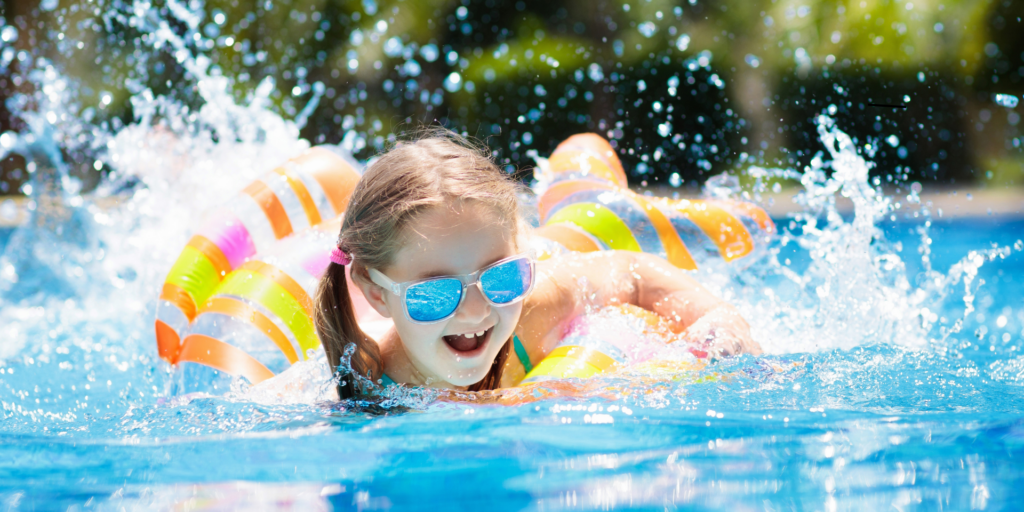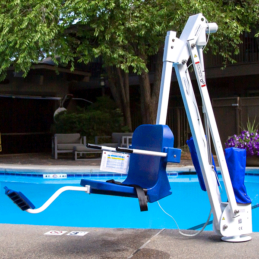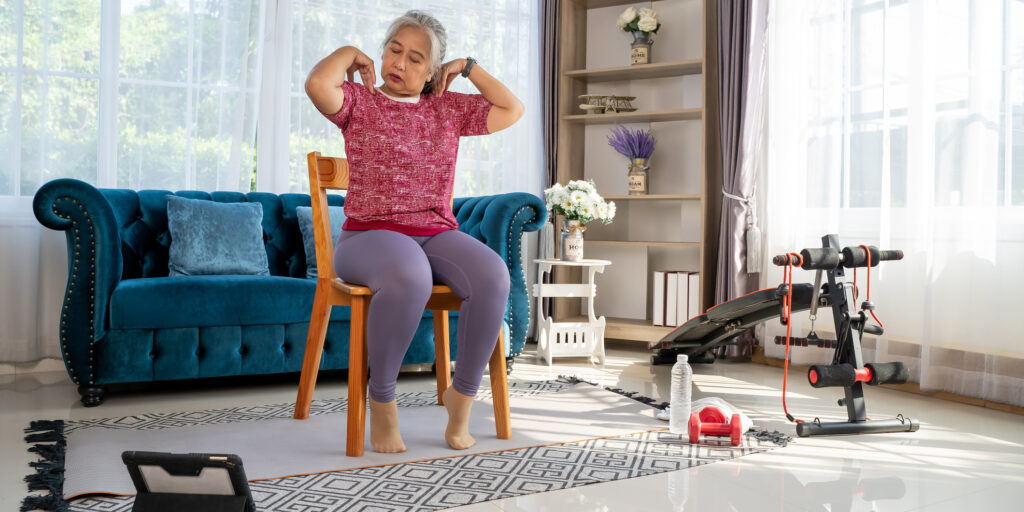
Splash Into Accessible Swimming This Summer
By Rebecca Hume | Tuesday, June 18, 2024
Summertime often brings to mind sunshine, blue skies, cook-outs, yard games…and swimming! Having fun in the pool is a refreshing way to get exercise, socialize or relax, and cool off from the season’s hot temperatures. For most MDA Summer Camp attendees and alumni, swimming in the pool at camp consistently holds the number one spot as the highlight activity of the week! Many campers share that camp was their first – and favorite – experience swimming. As MDA Summer Camp campers can attest, living with a neuromuscular disease does not need to prevent anyone from enjoying time in the water in their communities. In fact, there are many accessibility tools and devices that significantly limit the barriers to swimming.
Of course, water safety is an important consideration for all swimmers, whether living with a disability or not. The general rules of never swimming alone, using flotation devices if you are unable to swim independently, and always ensuring that a lifeguard or adult swimmer trained in pool safety and CPR are present apply to everyone. For those living with a disability, it is important to also discuss additional safety precautions or needs with a doctor or physical therapist and to utilize recommended accessibility equipment suitable to individual needs.
While there are additional considerations for swimmers with neuromuscular disease, there are also specific perks to spending time in the water. Water buoyancy alleviates pressure on joints and muscles and allows muscles with limited range of motion and/or strength to move without the resistance of gravity and weight. Floating and gently moving in the water is a low-impact opportunity to increase movement without exertion or injury. The social nature of swimming also provides an environment to spend time with friends and family while engaging in a fun activity.
Swimming is good for your physical, social, and mental health – and these tips and tools can help you make the most of your summer!
Finding accessible pools near you
Based on ADA guidelines, larger community pools are required to provide at least two accessible ways to enter the pool, one of which must either be a pool lift or a smooth, slanted entrance to shallow water. Smaller pools are sometimes only required to offer one of these options. But all public pools are obligated by law to provide adequate accessible options for people with disabilities to enter a pool. When planning a trip to your local pool, call ahead to determine what type or types of accessible entry are available.
Pool lifts, like this one, require an individual to transfer to a seated lift that lowers them into the water. Assistance is usually required to transfer, affix safety straps, and then release safety straps once the swimmer is in the water. If a swimmer requires a flotation devices or water aid that they cannot wear while being transferred, it is important to plan ahead and have someone in the water to help put on the flotation device before transferring off of the pool lift.

The ADA requires community pools to provide accessible points of entry to the swimming pool.
Pools with sloped entries, meaning that there are not steps to enter the pool but instead the sidewalk creates a ramp into the shallow end of the water, can be entered by walking, using a pool walker, or even using a pool wheelchair. Pool wheelchairs can only be used to enter the water, with assistance, deep enough for the buoyancy to assist transfer from the wheelchair (and users should never be strapped in). Once a swimmer has entered the shallow end using a pool chair, a caregiver or friend should be present to assist in the water or to help set a swimmer up with a flotation device or water aid.
Once in the pool, there are quite a few options for safety and support. Because being in water significantly limits the burden of gravity, swimmers can opt for a hands-on assist from a caregiver or friend to ensure safety, select a flotation device or water aid specific to their own needs and abilities, or utilize both.
A variety of flotation devices and water mobility aids
The most important thing to understand about pool safety and flotation devices is recognizing that supervision is always required – and hands-on assistance is sometimes also required even when using a flotation device or water mobility aid. Some individuals with a disability may be able to safely use a flotation device to float and swim independently, but it is still important to have another swimmer who is able to assist in an emergency or if the swimmer separates from the device. And for swimmers who cannot utilize a flotation device independently, they can still enjoy the pleasures of the pool by having a friend or caregiver next to them to provide hands on assistance using the flotation device. It is important to note that before a swimmer with neuromuscular disease uses a floatation device, he or she should check with their care team to ensure that it is an appropriate choice. And what works for one person may not work for another, which sometimes means trying a couple different types of devices or methods before finding the right fit to feel comfortable and safe.
Popular flotation devices and waiter aids in the disability community include:
- Standard swim vests and swim jackets often meet the needs of those living with a neuromuscular disease. The ability to safely walk or float in a pool wearing a swim vest is dependent upon each individual’s physical abilities, but there are a wide variety of options for adults and children.
- Specialized floating/swim vests for children and adults and adapted life vests can offer additional head support and stability.
- Pool noodles are flexible and easy to bend and shape to rest arms on and stay afloat or gain additional stability while standing or walking in water. Inflatable pool noodle sling chairs and inflatable floating water chairs can make floating and relaxing comfortable and easy.
- Aquatic walkers and water-walking assistants, often used in physical therapy, provide added support to swimmers who may have weakness, fatigue, or limited movement in their lower extremities but have the upper body strength and dexterity to hold onto the walking frame.
- Stabilizing belts and bars allow swimmers with some upper body dexterity to stand and walk upright in water while holding on to the floating bar. There are a variety of stabilizing belts and floatation belts on the market; these are also often used for physical and recreational therapy.
A physical therapist may be able to recommend additional water aids to increase safety and independence in the swimming pool, as well as water exercises that can benefit those living with neuromuscular disease. It is important to note that these aids are not certified personal flotation devices or life-saving devices and that they should always be used with supervision and/or hands-on assistance from an adult swimmer. But with a little planning and a partner for the pool, these products can help everyone splash into summer fun.
Next Steps and Useful Resources
- Stay up-to-date on Quest content! Subscribe to Quest Magazine and Newsletter.
Disclaimer: No content on this site should ever be used as a substitute for direct medical advice from your doctor or other qualified clinician.




